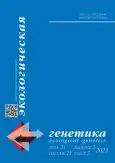Vol 21, No 2 (2023)
- Year: 2023
- Published: 16.08.2023
- Articles: 5
- URL: https://journals.eco-vector.com/ecolgenet/issue/view/7169
- DOI: https://doi.org/10.17816/ecogen.212
Genetic basis of ecosystems evolution
Molecular screening of squash and patisson squash collection samples using markers of the Pm-0 gene, which controls resistance to powdery mildew
Abstract
Powdery mildew (PM) is one of the most harmful diseases of cucurbits. Modern commercial varieties of squash Cucurbita pepo L. var. giraumonas Duch and patisson C. pepo var. melopepo L. received powdery mildew resistance genes from wild species. The Pm-0 resistance gene belongs to the linkage group 10; two CAPS markers were developed for its mapping [15]. The main intragenic marker NBS_S9_1495924/HaeIII is localized in the NBS-LRR region, the additional marker S9_1539675/MspI shows complete co-segregation with resistance to PM [15]. In the present study, these markers were used for molecular screening of an experimental set of squash and patisson samples (differ in resistance to powdery mildew) from the VIR gene bank collection and perspective breeding lines of the Krymsk Experiment Breeding Station – branch of VIR. In total, 80 samples were investigated. Samples, carrying fragments of both CAPS markers (17) and fragments of only one marker (31) were found. Presence of two markers of the Pm-0 gene (NBS_S9_1495924/HaeIII и S9_1539675/MspI) has the strong correlation with resistance to PM (r = 0.837).
For three powdery mildew-resistant samples, which has demonstrated presence of both markers of the Pm-0 gene, additional analysis of individual plants was done. Resistant plants with Pm-0 gene markers were self-pollinated to create resistant lines. Thus, molecular screening allowed to preserve the valuable trait of resistance during maintaining of the squash collection samples.
 107-121
107-121


Endophytic microorganisms of potato (Solanum tuberosum L.): biodiversity, functions and biotechnological potential
Abstract
Endophytic communities represent a fascinating inner world of the plants. Endophytes are found in all plant species studied, though the number of microbial cells and their species diversity can differ a lot. The potato (Solanum tuberosum L.) is economically important staple food crop, and the induction of plant resistance to various infections as well as the search for the effective eco-friendly preparations could provide higher potato yields and are very promising for modern agriculture. In this review, we focus on the biodiversity of the potato endophytes and the aspects of their functional importance and possible application in the biological control of plant pathogens. We have systematized literature data regarding the prevention of the harmful effect of pathogenic fungi, bacteria, viruses, and insects resulting from the vital activity of the endophytic microorganisms within the potato plants.
 123-135
123-135


The diversity of genes for the synthesis of opines and their products in representatives of various taxa
Abstract
Opines are low molecular weight organic substances that occur in marine invertebrates, bacteria, some plants and fungi. Such an unusual range of organisms suggests the importance of studying and systematizing knowledge about the functions of these compounds and the genetic control of their metabolism. In recent years, new data have emerged on plants containing genes for the synthesis of opines as a result of horizontal gene transfer from agrobacteria. This review is devoted to systematization of information about opine synthase genes, their products and functions of the latter.
 137-154
137-154


Variability in the productivity of peanut accessions (Arachis hypogaea L.) at ecological-geographical testing
Abstract
BACKGROUND: Russia is one of the largest peanut-buying countries. At the same time, in the south of the country, a number of zones meet the requirements for the cultivation of peanuts.
AIM: Identification of a new source material for peanut breeding by the method of ecological and geographical testing of collection samples.
MATERIALS AND METHODS: The work used 30 of peanuts accessions from the VIR collection of various origins. To assess the stability of productivity, standard deviation (s), coefficient of variation (Cv) and regression (βi) for environmental conditions according to Eberhart and Russell were used.
RESULTS: As a result of the study, the possibility of growing individual varieties of peanuts in the south of the RF under modern conditions was confirmed. It was determined that some samples are more productive and suitable as starting material for the conditions of the Krasnodar Territory (k-283, k-1157), others — for the conditions of the Astrakhan region (k-317, k-868). The accessions of the VIR collection were found to be more productive at 2 points experience, also marked as plasticity k-751, k-283, k-626, k-1533, k-1987.
CONCLUSIONS: In contrasting conditions (two geographical points for 3 years of study), peanuts accessions were identified that strongly react to changes in environmental conditions. Stable and plastic in productivity accessions can serve as the initial breeding material. It has been established that peanuts can be cultivated in the south of the Russian Federation, namely in the Astrakhan Region and the Krasnodar Territory.
 155-165
155-165


6. History, personalities, book reviews, information
Stanislava I. Narbut, the author of the first radish genetic collection in Russia
Abstract
Stanislava Iosifovna Narbut (1909–2001) was an agronomist, a graduate of the Leningrad Agricultural Institute. She worked as a Senior Researcher at the Plant Genetics Laboratory of the Biological Research Institute of the Leningrad State University from 1949 to 1985. S.I. Narbut was a creator of radish inbred lines genetic collection at Leningrad State University. This article discusses the main milestones of S.I. Narbut’s biography and presents a series of previously unpublished photographs and memoirs of her colleagues and students.
 167-182
167-182












